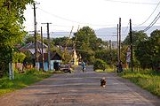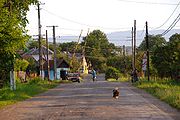
Bocicoiu Mare
Encyclopedia
Bocicoiu Mare is a commune in Maramureş County
, Romania
. It lies 9 kilometres east of Sighetu Marmaţiei
; across the Tisza River
from Velykyy Bychkiv
, Ukraine
.
 The village was first mentioned in 1373, by the name Boshko. Its name derives from a Slavic word meaning "bull
The village was first mentioned in 1373, by the name Boshko. Its name derives from a Slavic word meaning "bull
". From 1556 it belonged to the Báthory
family. By 1711 a mansion already stood here. After the failed revolution led by Francis II Rákóczi
, Germans settled down in the area.
The village was known as Németbocskó ("German Bocskó", later called Újbocskó or "New Bocskó") and was united with two villages (Nagybocskó and Kisbocskó; "Greater" and "Smaller" Bocskó) across the river, forming a greater village called Nagybocskó. This village had thus three parts: Újbocskó, which forms today's Bocicoiu Mare, and Kisbocskó and Nagybocskó, which form today's Velykyy Bychkiv.
Lunca la Tisa was part of the former Hungarian
village of Lonka, which was cut into two parts after the World Wars, when the Tisza
River became a natural border between Romania and Ukraine
. Its Ukrainian half forms the village of Luh (Луг).
, 1646 Hungarians and 1177 Germans
. It belonged to the Hungarian county of Máramaros
. After World War I
the village was split in two, and the river became a natural border of the two countries (with Velykyy Bychkiv in Czechoslovakia
until 1945, before being incorporated into the Ukrainian SSR
).
At the 2002 census, 59.1% of inhabitants were Ukrainians
, 32.4% Romanians
and 8.3% Hungarians. 76.8% were Romanian Orthodox, 8.5% Roman Catholic, 8.2% Greek-Catholic
and 4.7% stated they belonged to another religion.
Maramures County
Maramureș is a county of Romania, in the Maramureș region. The county seat is Baia Mare.- History :* The 10th century frontier county of Borsova was founded by Stephen I of Hungary. Since then Máramaros served as the north-eastern border of the Hungarian Kingdom until 1920, the Trianon Peace...
, Romania
Romania
Romania is a country located at the crossroads of Central and Southeastern Europe, on the Lower Danube, within and outside the Carpathian arch, bordering on the Black Sea...
. It lies 9 kilometres east of Sighetu Marmaţiei
Sighetu Marmatiei
Sighetu Marmației , formerly Sighet, is a city in Maramureş County near the Iza River, in north-western Romania. It administers five villages: Iapa, Lazu Baciului, Șugău, Valea Cufundoasă and Valea Hotarului.-Geography:...
; across the Tisza River
Tisza
The Tisza or Tisa is one of the main rivers of Central Europe. It rises in Ukraine, and is formed near Rakhiv by the junction of headwaters White Tisa, whose source is in the Chornohora mountains and Black Tisa, which springs in the Gorgany range...
from Velykyy Bychkiv
Velykyy Bychkiv
Velykyi Bychkiv is a town in the Rakhiv Raion of Zakarpattia Oblast , in the west-most part of Ukraine. It has a population of 9,423 and lies 36 kilometres east of Tiachiv, where the river Sopurka meets the Tisza River....
, Ukraine
Ukraine
Ukraine is a country in Eastern Europe. It has an area of 603,628 km², making it the second largest contiguous country on the European continent, after Russia...
.
Villages
The commune is composed of four villages: Bocicoiu Mare, Crăciuneşti, Lunca la Tisa and Tisa.History

Bull
Bull usually refers to an uncastrated adult male bovine.Bull may also refer to:-Entertainment:* Bull , an original show on the TNT Network* "Bull" , an episode of television series CSI: Crime Scene Investigation...
". From 1556 it belonged to the Báthory
Báthory
The Báthory were a Hungarian noble family of the Gutkeled clan. The family rose to significant influence in Central Europe during the late Middle Ages, holding high military, administrative and ecclesiastical positions in the Kingdom of Hungary...
family. By 1711 a mansion already stood here. After the failed revolution led by Francis II Rákóczi
Francis II Rákóczi
Francis II Rákóczi Hungarian aristocrat, he was the leader of the Hungarian uprising against the Habsburgs in 1703-11 as the prince of the Estates Confederated for Liberty of the Kingdom of Hungary. He was also Prince of Transylvania, an Imperial Prince, and a member of the Order of the Golden...
, Germans settled down in the area.
The village was known as Németbocskó ("German Bocskó", later called Újbocskó or "New Bocskó") and was united with two villages (Nagybocskó and Kisbocskó; "Greater" and "Smaller" Bocskó) across the river, forming a greater village called Nagybocskó. This village had thus three parts: Újbocskó, which forms today's Bocicoiu Mare, and Kisbocskó and Nagybocskó, which form today's Velykyy Bychkiv.
Lunca la Tisa was part of the former Hungarian
Hungary
Hungary , officially the Republic of Hungary , is a landlocked country in Central Europe. It is situated in the Carpathian Basin and is bordered by Slovakia to the north, Ukraine and Romania to the east, Serbia and Croatia to the south, Slovenia to the southwest and Austria to the west. The...
village of Lonka, which was cut into two parts after the World Wars, when the Tisza
Tisza
The Tisza or Tisa is one of the main rivers of Central Europe. It rises in Ukraine, and is formed near Rakhiv by the junction of headwaters White Tisa, whose source is in the Chornohora mountains and Black Tisa, which springs in the Gorgany range...
River became a natural border between Romania and Ukraine
Ukraine
Ukraine is a country in Eastern Europe. It has an area of 603,628 km², making it the second largest contiguous country on the European continent, after Russia...
. Its Ukrainian half forms the village of Luh (Луг).
Demographics
In 1910 the village had 5955 inhabitants: 3078 RusynsRusyns
Carpatho-Rusyns are a primarily diasporic ethnic group who speak an Eastern Slavic language, or Ukrainian dialect, known as Rusyn. Carpatho-Rusyns descend from a minority of Ruthenians who did not adopt the use of the ethnonym "Ukrainian" in the early twentieth century...
, 1646 Hungarians and 1177 Germans
Germans
The Germans are a Germanic ethnic group native to Central Europe. The English term Germans has referred to the German-speaking population of the Holy Roman Empire since the Late Middle Ages....
. It belonged to the Hungarian county of Máramaros
Máramaros
Máramaros is the name of a historic administrative county of the Kingdom of Hungary. Its territory is presently in north-western Romania and western Ukraine...
. After World War I
World War I
World War I , which was predominantly called the World War or the Great War from its occurrence until 1939, and the First World War or World War I thereafter, was a major war centred in Europe that began on 28 July 1914 and lasted until 11 November 1918...
the village was split in two, and the river became a natural border of the two countries (with Velykyy Bychkiv in Czechoslovakia
Czechoslovakia
Czechoslovakia or Czecho-Slovakia was a sovereign state in Central Europe which existed from October 1918, when it declared its independence from the Austro-Hungarian Empire, until 1992...
until 1945, before being incorporated into the Ukrainian SSR
Ukrainian SSR
The Ukrainian Soviet Socialist Republic or in short, the Ukrainian SSR was a sovereign Soviet Socialist state and one of the fifteen constituent republics of the Soviet Union lasting from its inception in 1922 to the breakup in 1991...
).
At the 2002 census, 59.1% of inhabitants were Ukrainians
Ukrainians
Ukrainians are an East Slavic ethnic group native to Ukraine, which is the sixth-largest nation in Europe. The Constitution of Ukraine applies the term 'Ukrainians' to all its citizens...
, 32.4% Romanians
Romanians
The Romanians are an ethnic group native to Romania, who speak Romanian; they are the majority inhabitants of Romania....
and 8.3% Hungarians. 76.8% were Romanian Orthodox, 8.5% Roman Catholic, 8.2% Greek-Catholic
Romanian Church United with Rome, Greek-Catholic
The Romanian Church United with Rome, Greek-Catholic is an Eastern Catholic Church which is in full union with the Roman Catholic Church. It is ranked as a Major Archiepiscopal Church and uses the Byzantine liturgical rite in the Romanian language....
and 4.7% stated they belonged to another religion.
Main sights
- Its Roman CatholicRoman Catholic ChurchThe Catholic Church, also known as the Roman Catholic Church, is the world's largest Christian church, with over a billion members. Led by the Pope, it defines its mission as spreading the gospel of Jesus Christ, administering the sacraments and exercising charity...
church was built in the 14th century in Gothic style architectureGothic architectureGothic architecture is a style of architecture that flourished during the high and late medieval period. It evolved from Romanesque architecture and was succeeded by Renaissance architecture....
, but it was rebuilt several times and lost its Gothic elements.

